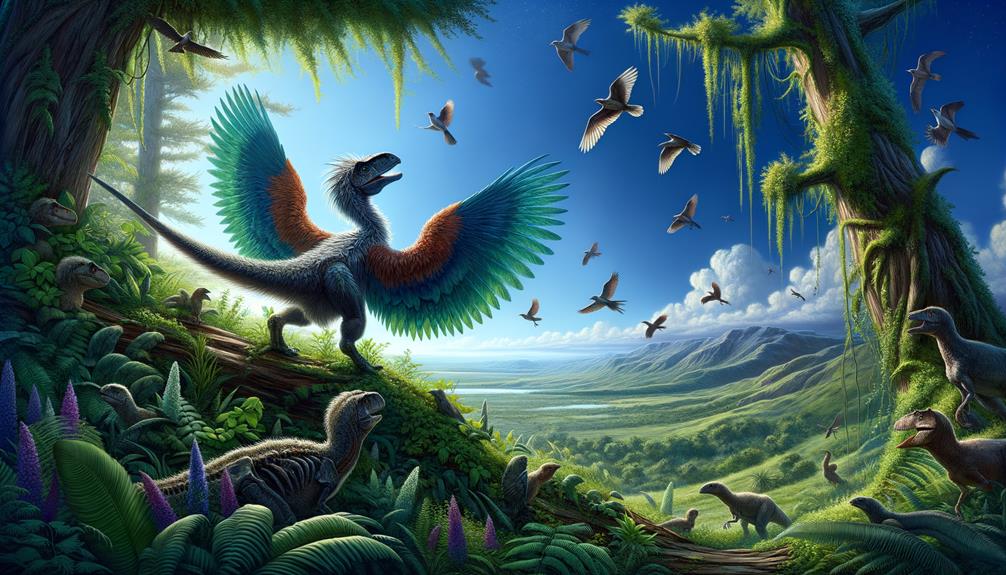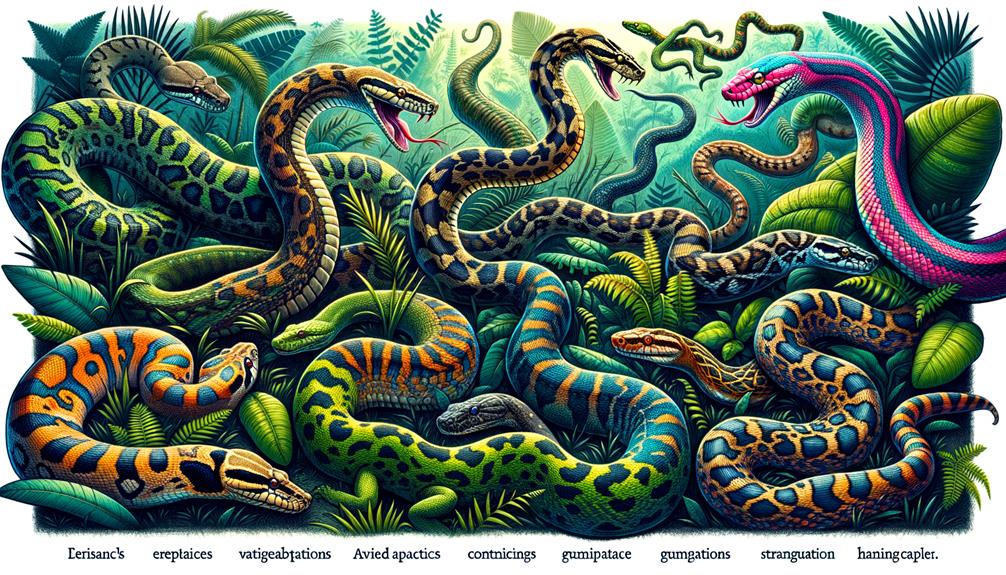Exploring reptilian evolutionary origins takes us back to around 318-312 million years ago, when early amniotes first emerged, marking a significant turning point in vertebrate evolution. This split from amphibians allowed for the development of the amniotic egg, which in turn enabled life on land. Reptiles like Hylonomus and Paleothyris successfully made the transition from water to land. Major groups, including turtles, lizards, and crocodiles, evolved unique adaptations to thrive in their environments. Fossil records and genetic analysis provide valuable insights into these evolutionary milestones, highlighting the remarkable adaptations that enabled reptiles to survive through mass extinctions. By understanding these origins, we uncover the complexities of reptilian history and gain a deeper appreciation for their resilience.
Key Takeaways
Early amniotes emerged around 318-312 million years ago, marking a significant turning point in the evolution of terrestrial vertebrates. The development of the amniotic egg was a crucial innovation that allowed reptiles to reproduce and thrive on land without needing to return to water.
Turtles and tortoises branched off from other reptiles around 220 million years ago, developing unique bony shells that provided them with protection.
Lizards and snakes, also known as lepidosaurs, diverged from other reptile lineages in the Late Permian period. Snakes evolved from burrowing lizard-like ancestors, adapting to their environment in unique ways.
The Late Triassic period saw the emergence of archosaurs, a group that includes crocodiles, dinosaurs, and birds. This marked a significant diversification of major reptilian groups, with each lineage developing distinct characteristics.
Early Amniotes
The emergence of early amniotes, which diverged from amphibians around 318-312 million years ago during the Early Pennsylvanian period, marks a significant milestone in vertebrate evolution. As members of Tetrapoda, amniotes represent a crucial step in evolution that allowed vertebrates to break free from the aquatic constraints of their amphibian ancestors. This divergence was vital, as it led to the development of traits that enabled these creatures to thrive in terrestrial environments more effectively.
The key innovation that made this shift possible was the amniotic egg. Unlike amphibians, which relied on water bodies for reproduction, early amniotes developed eggs encased in a protective shell. This allowed embryos to develop on land, giving amniotes the freedom to explore and colonize a wider range of ecological niches.
Among the earliest known reptiles, Hylonomus and Paleothyris, discovered in the Late Carboniferous of North America, exemplify this evolutionary leap. Their existence demonstrates the successful transition from water to land, setting the stage for the diverse array of reptiles that would follow. The evolution of the amniote lineage, therefore, represents a foundational chapter in the broader narrative of vertebrate history.
Major Reptilian Groups
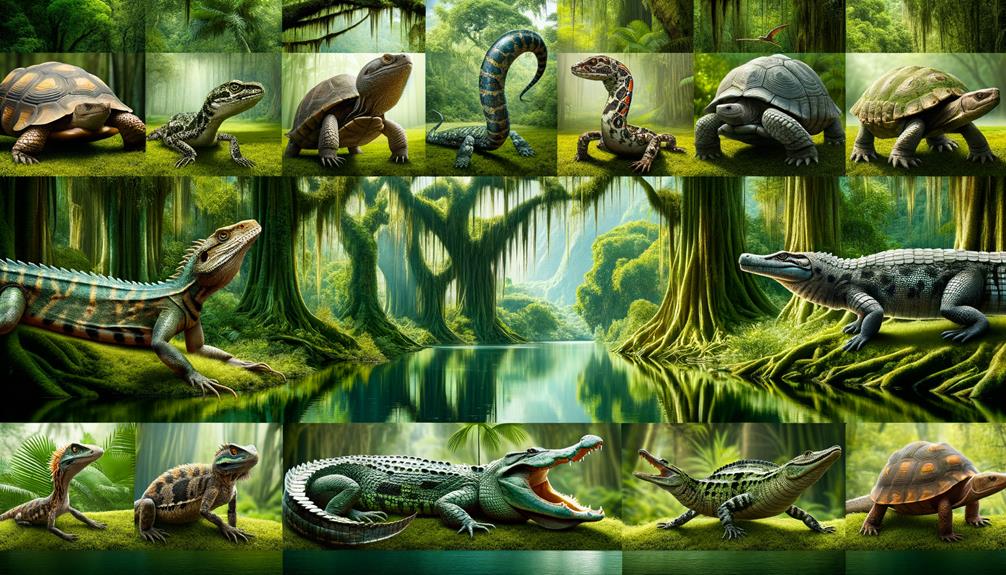
I find it fascinating how modern reptiles have evolved from distinct lineages. Turtles and tortoises, belonging to the order Testudines, have developed unique structural adaptations to thrive in various environments. Meanwhile, lizards and snakes, as well as crocodiles and alligators, showcase an array of evolutionary innovations that highlight their distinct ecological niches and survival strategies.
Turtles and Tortoises
Turtles and tortoises, belonging to the order Testudines, have undergone a remarkable evolution since the Late Triassic period. Their unique bony shells and adaptability to diverse habitats are a testament to their resilience. Having diverged from other reptiles around 220 million years ago, they have left behind a rich fossil record that fascinates vertebrate paleontologists.
The bony shell, a distinctive feature of Testudines, evolved from fused vertebrae, ribs, and a broadened pelvis. This protective armor has enabled these animals to thrive in various environments, from aquatic ecosystems to arid deserts. Over millions of years, turtles and tortoises have adapted to a wide range of habitats, showcasing their incredible versatility.
Some species of Testudines are among the longest-lived vertebrates, with lifespans exceeding 100 years in the wild. Their diets vary widely, with most being herbivores, while some are omnivorous, consuming plants, insects, and small animals. As a result, they play a vital role in maintaining the health of their ecosystems through seed dispersal and food web dynamics.
Their remarkable longevity and adaptability make turtles and tortoises essential components of their ecosystems. By understanding their evolution and ecological roles, we can better appreciate the importance of preserving their habitats and protecting these remarkable creatures.
Lizards and Snakes
Diving into the fascinating world of lizards and snakes, we uncover a complex evolutionary history that dates back to the Late Permian period, around 295 million years ago. This era marks the divergence of lepidosaurs, the group encompassing lizards and snakes, from other reptile lineages. The subsequent Age of Reptiles, particularly the Late Triassic around 225 million years ago, saw the emergence of squamates, which would eventually lead to a remarkable diversification, culminating in over 10,000 species today.
Snakes, which evolved from small, burrowing lizard-like ancestors in the Middle Jurassic around 170 million years ago, showcase one of the most intriguing evolutionary adaptations. Their ability to thrive in both terrestrial and aquatic habitats highlights the dynamic nature of reptile evolution. Geckos, ancient and diverse, appeared in the Late Triassic, developing unique adaptations like adhesive toe pads, demonstrating the evolutionary ingenuity of lizards.
Other notable lineages, such as iguanas, chameleons, and anoles, have evolved to occupy varied ecological niches worldwide, emphasizing the adaptive versatility of lizards. These groups highlight the intricate and ongoing process of reptilian evolution, painting a vivid picture of life's adaptability and resilience.
Crocodiles and Alligators
Among the major reptilian groups, crocodiles and alligators stand out as remarkable survivors, tracing their lineage back to the archosaur clade that also gave rise to dinosaurs and pterosaurs. Their history dates back to the Late Triassic period, approximately 230 million years ago, testifying to their resilience and adaptability. These semiaquatic reptiles have developed unique body plans that make them top predators in their respective ecosystems.
At the National Museum of Natural History in New York, visitors can explore exhibits that detail the evolutionary journey of these ancient creatures. Crocodilians possess a nictitating membrane, a transparent third eyelid that provides underwater vision protection – a feature that highlights their mastery of both land and water environments.
Today, modern reptiles, such as alligators in the southeastern United States and eastern China, and crocodiles in the tropics of Africa, Asia, Australia, and the Americas, continue to thrive. Their powerful jaws and teeth enable them to catch and consume a wide variety of prey, from fish to mammals. By examining these remarkable reptiles, we gain a deeper understanding of the evolutionary processes that have shaped their survival and dominance across millions of years.
Fossil Evidence
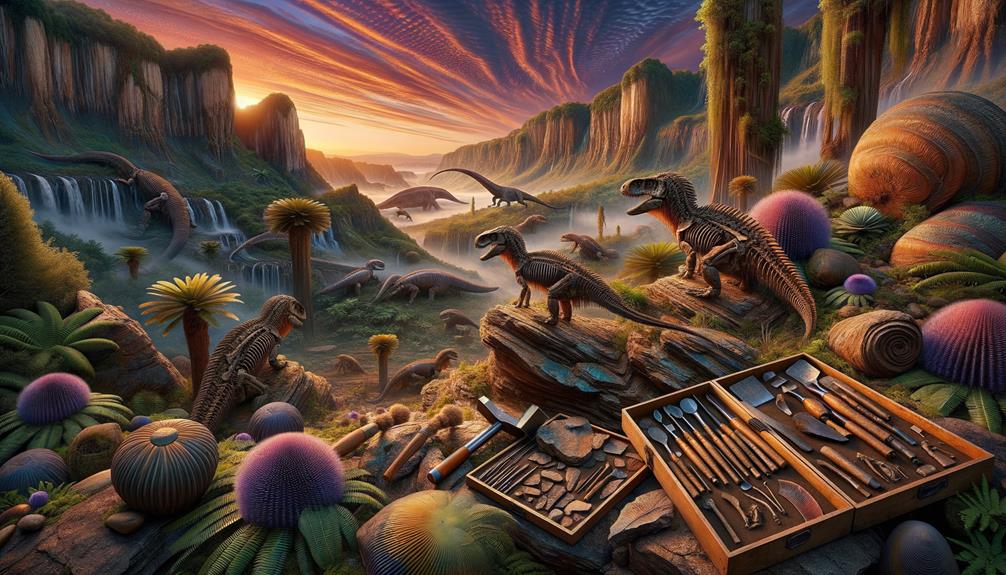
Examining the fossil record, we find that the earliest known reptiles, Hylonomus and Paleothyris, date back approximately 310 million years to the Late Carboniferous period in North America. These early reptiles laid the groundwork for the incredible diversity we see today, including lizards and snakes. Their existence provides vital insights into the evolutionary path that led to modern reptilian forms.
Moving forward in time, we come across captorhinids, broad-headed lizard-like reptiles, which dominated most of the Permian period. These creatures show an early adaptation towards more terrestrial lifestyles. By the Late Permian, lepidosauromorphs emerged, forming the ancestral lineage that led to today's tuatara and squamates. This group is notable for its role in the eventual diversification of lizards and snakes.
In the Early Triassic period, ichthyosaurs and sauropterygians – aquatic saurian reptiles – appeared, showcasing a remarkable shift towards specialized marine adaptations. Shortly thereafter, the Middle Triassic period witnessed the rise of archosauromorphs, which include the ancestors of dinosaurs, crocodiles, and birds. These transformations in the fossil record reveal the dynamic and adaptive nature of reptilian evolution, highlighting the profound changes that have occurred over millions of years.
Phylogenetic Relationships
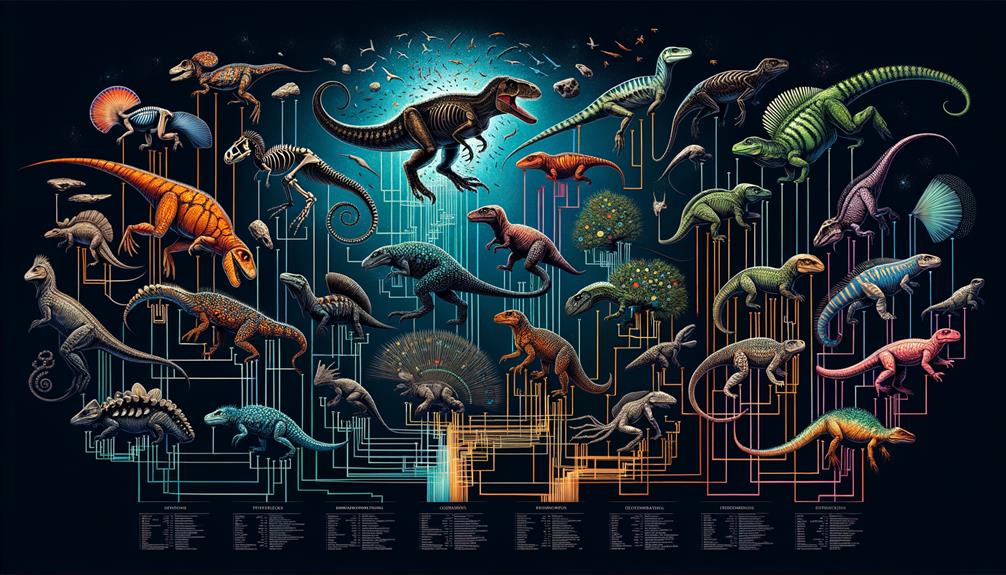
As I delve into the phylogenetic relationships among reptiles, the crucial divergence of lineages provides vital clues about their evolutionary journey. By using cutting-edge genetic analysis, we can untangle the complex branching of reptilian family trees and back it up with fossil evidence. This approach gives us a clearer picture of how modern reptiles evolved from their ancient ancestors.
Ancestral Lineage Divergence
Tracing the evolutionary history of amniotes, we find that the divergence from amphibians around 318-312 million years ago marked a significant turning point. This event paved the way for the emergence of the earliest known reptiles, such as Hylonomus and Paleothyris, in the Late Carboniferous of North America. These early reptiles laid the foundation for the evolutionary paths that would eventually give rise to the diverse reptilian groups we see today.
The true reptiles, or Eureptilia, differentiated themselves from the more primitive Parareptilia (anapsids) through distinct evolutionary pathways. While Parareptilia retained more ancestral traits, Eureptilia displayed advancements that set the stage for further diversification. Among these were the Lepidosauromorphs, the lineage leading to modern tuatara and squamates, which emerged during the Late Permian period. This group's evolution showcased the adaptability of reptiles in various ecological niches.
In the Middle Triassic period, Archosauromorphs, the lineage that encompasses dinosaurs, crocodiles, and birds, arose. This clade's evolutionary success highlighted the adaptive radiation and the varied morphologies reptiles could achieve. Understanding these phylogenetic relationships provides valuable insights into the ancestral lineage divergence that shaped the reptilian domain.
Genetic Analysis Techniques
Advanced genetic analysis techniques allow us to unravel the complex evolutionary relationships that define reptilian lineages. By analyzing DNA sequence data, we can reconstruct the evolutionary relationships and divergence times among various reptile groups. The molecular clock dating technique is crucial in estimating the timing of key events, such as the split between lizards and snakes.
Comparing genomes of different reptiles reveals the genetic changes underlying the development of distinct body plans and adaptations. For instance, by comparing the genomes of different reptiles, we can identify genes responsible for unique traits, shedding light on their evolutionary significance.
The use of mitochondrial and nuclear gene sequencing has provided clarity on the phylogenetic placement of turtles, which was once a contentious issue. These techniques have shown that turtles share a closer evolutionary relationship with other reptiles than previously thought.
Fossil Record Insights
By examining the fossil record, we can gain a deeper understanding of reptilian evolution and relationships. The earliest known reptiles, Hylonomus and Paleothyris, from the Late Carboniferous period of North America, provide valuable insights into the initial stages of reptilian evolution. These early reptiles paved the way for the emergence of Eureptilia, or 'true reptiles,' from the more primitive Parareptilia during the Early Pennsylvanian.
The presence of Captorhinids throughout most of the Permian period highlights the diversity and adaptability of reptilian forms during this era. These broad-headed, lizard-like reptiles offer a glimpse into the evolutionary pressures and ecological niches that shaped early reptilian life. The appearance of Lepidosauromorphs in the Late Permian marks the origin of the lineage leading to modern tuatara and squamates, underscoring the long-term continuity within this group.
Archosauromorphs, which include the ancestors of dinosaurs and the crocodile-bird lineage, emerged in the Middle Triassic. This development marks a significant milestone in reptilian evolution, leading to some of the most iconic reptilian forms.
| Period | Reptilian Group | Significance |
|---|---|---|
| Late Carboniferous | Hylonomus, Paleothyris | Earliest known reptiles |
| Early Pennsylvanian | Eureptilia | Divergence from Parareptilia |
| Permian | Captorhinids | Broad-headed lizard-like reptiles |
| Late Permian | Lepidosauromorphs | Ancestors to tuatara and squamates |
| Middle Triassic | Archosauromorphs | Ancestors to dinosaurs, crocodiles, birds |
Through these fossil records, we gain a more comprehensive understanding of reptilian evolutionary history, filling in the gaps that genetic data alone cannot fill.
Adaptive Radiations
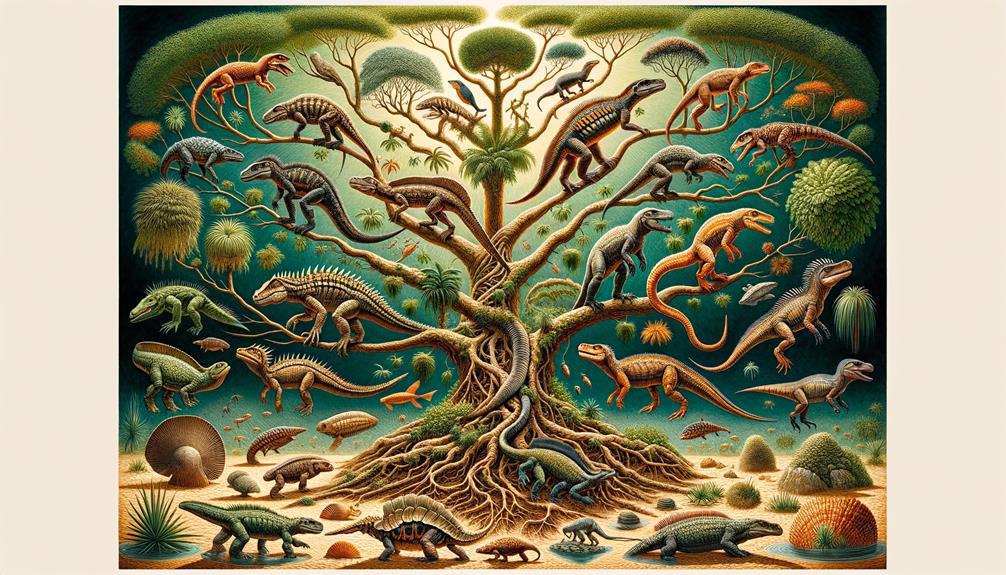
Although the theory of adaptive radiation has been a cornerstone in evolutionary biology for a long time, recent studies show that reptilian evolution occurred through numerous small bursts over 50 million years, rather than a single rapid event. This new understanding challenges the traditional view, suggesting a slower and more incremental process, particularly evident in the early evolution of most lizard lineages. Anatomical changes in these reptiles didn't coincide with rapid increases in genetic diversity or species abundance, indicating a gradual and persistent evolutionary pace.
After the mass extinction event known as the Great Dying, reptiles took nearly 10 million years to regain their previous levels of anatomical diversity. This prolonged recovery period highlights the complexity of evolutionary processes and the resilience required for anatomical diversification. The evolution of snakes further illustrates this complexity, as their body plans evolved at a different rate, indicating a mismatch between morphological and genetic changes.
These findings provide valuable insights into the extended timescales over which animals evolve. By challenging the long-held notion of adaptive radiation, they highlight the intricate relationship between morphology, genetics, and species diversity in the grand tapestry of reptilian evolution.
Impact on Biodiversity
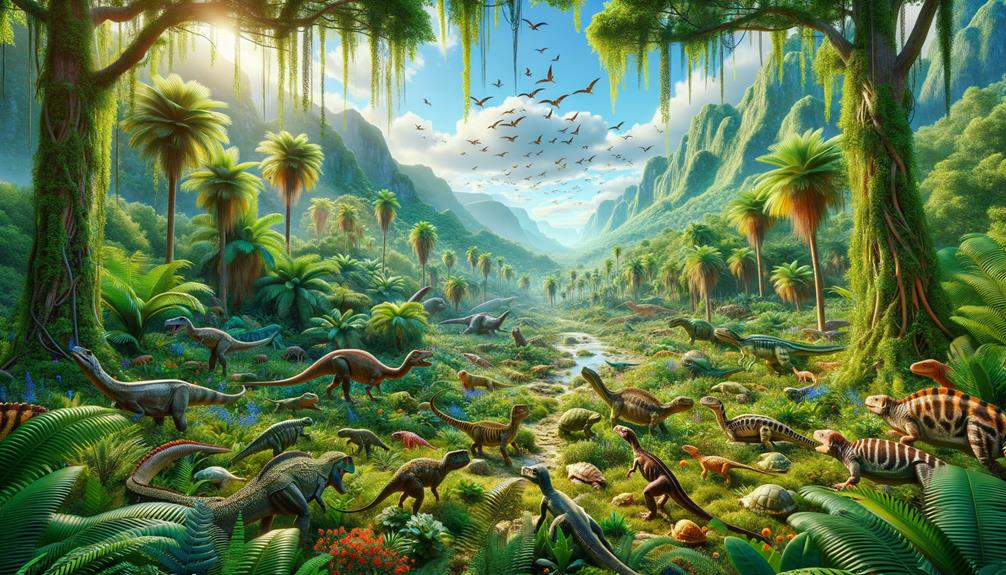
Understanding reptilian evolution provides a unique perspective on their significant impact on biodiversity throughout Earth's history. Reptiles have demonstrated remarkable resilience, having survived three major mass extinction events. Their adaptability is exemplified by their recovery and diversification following the Permian-Triassic mass extinction, which wiped out around 90% of Earth's species.
One critical adaptation, the development of the amniotic egg, allowed reptiles to conquer diverse terrestrial environments that were inaccessible to amphibians. This evolutionary leap enabled reptiles to spread across continents and diversify into numerous forms. The Mesozoic Era, often referred to as the 'Age of Reptiles,' saw the peak of reptilian diversity. Dinosaurs, pterosaurs, ichthyosaurs, plesiosaurs, and crocodilians dominated land, air, and sea, significantly shaping ecosystems.
Today, reptiles remain one of the most diverse groups of animals, with lineages like lizards, snakes, turtles, and crocodilians thriving in a wide range of habitats. Their continued success highlights their evolutionary adaptability and their ongoing impact on global biodiversity, underscoring the intricate interplay between evolutionary processes and ecological dynamics.
Frequently Asked Questions
What Are the Evolutionary Origins of Reptiles?
The evolutionary origins of reptiles date back to a common ancestor from the Early Pennsylvanian period, around 300 million years ago. This ancestor's groundbreaking adaptation – the amniotic egg – allowed reptiles to flourish in a wide range of terrestrial environments, leading to an explosion of diversity.
Did Humans Evolve From Reptiles?
Humans didn't evolve directly from reptiles; instead, we share a common ancestor that lived around 350 million years ago. This ancestor, a tetrapod, eventually gave rise to two distinct lineages: one leading to mammals, including humans, and the other to reptiles. The split occurred around 320 million years ago, marking the beginning of our separate evolutionary paths.
What Is the Ancestry of the Reptiles?
Imagine stumbling upon fossils of Hylonomus in ancient rocks. Reptiles branched off from early amniotes, splitting from amphibians during the Early Pennsylvanian period. This new path led to a wide range of species, thriving in various environments, with the amniotic egg being key to their success.
What Reptiles Existed Before Dinosaurs?
Before dinosaurs roamed the earth, reptiles like Hylonomus and Paleothyris dominated the Late Carboniferous period, while Captorhinids thrived during the Permian era. The ancestors of turtles, known as parareptiles, and Lepidosauromorphs, which would eventually give rise to lizards and snakes, also existed during this time.


